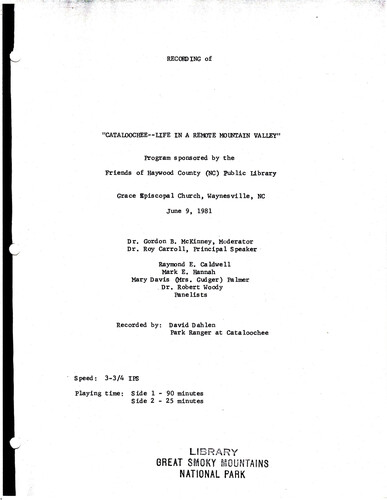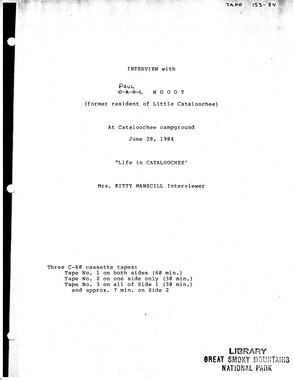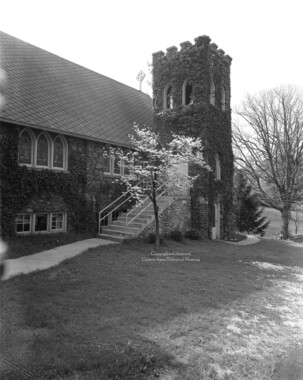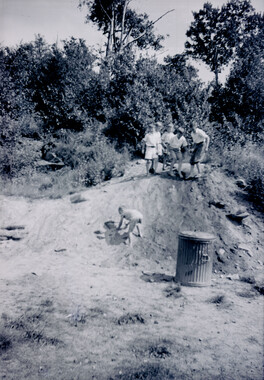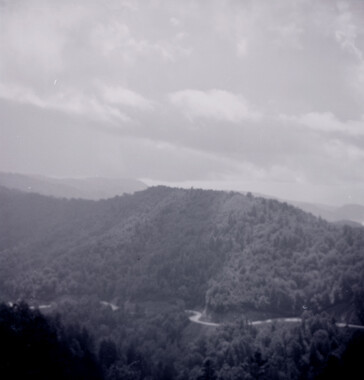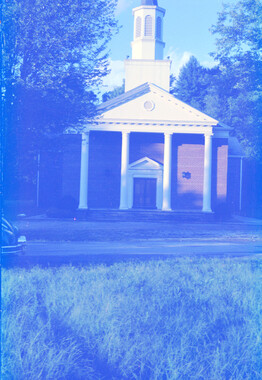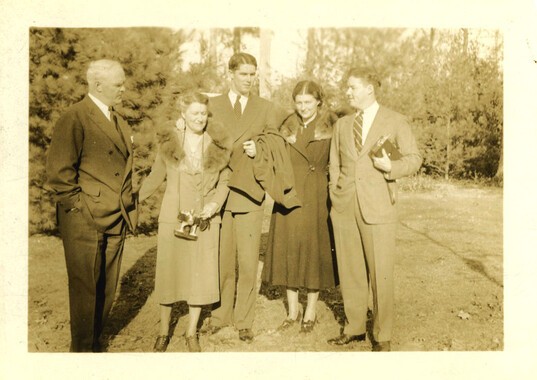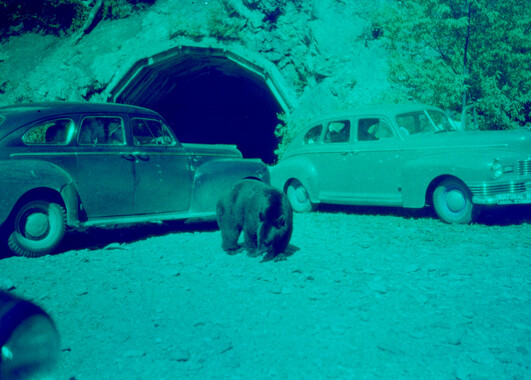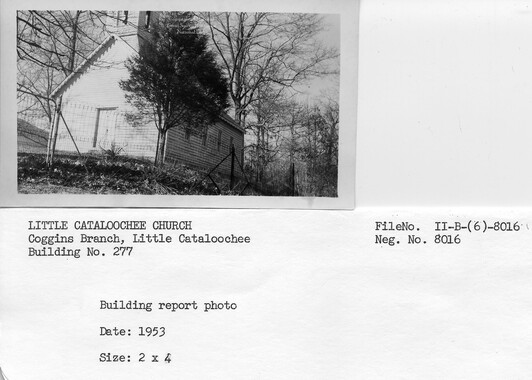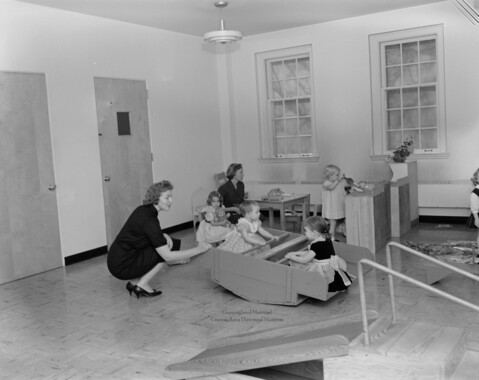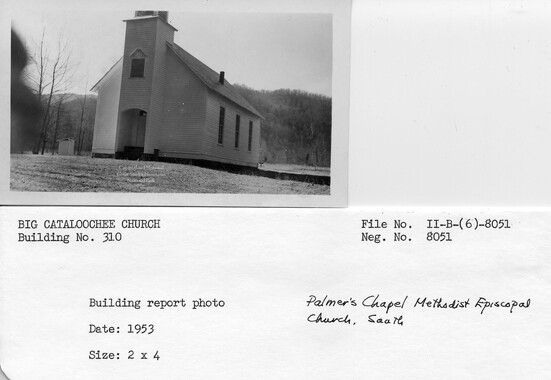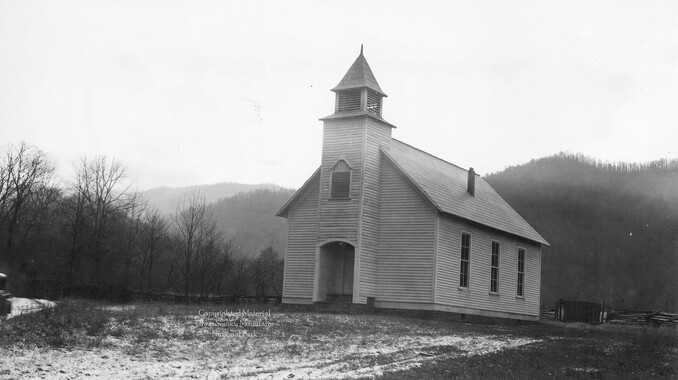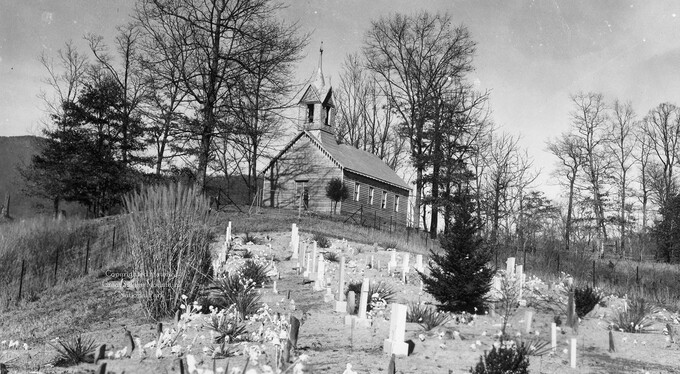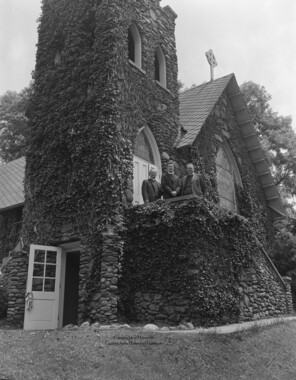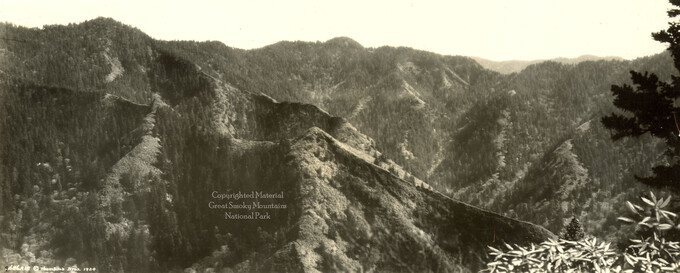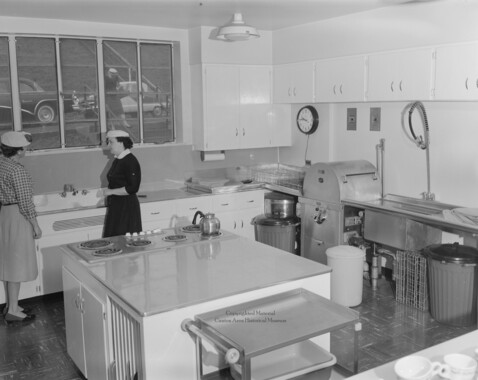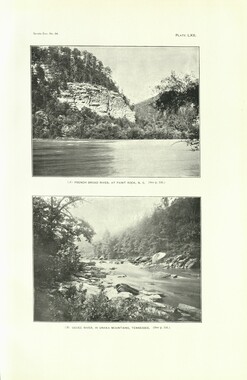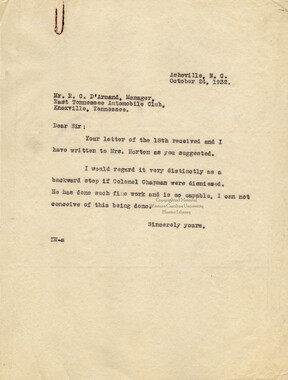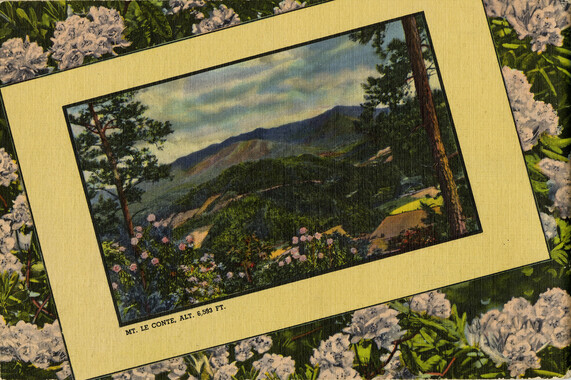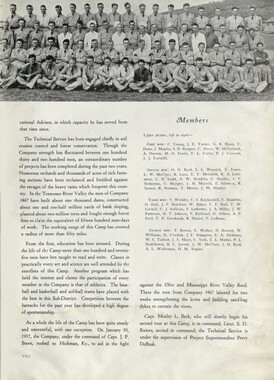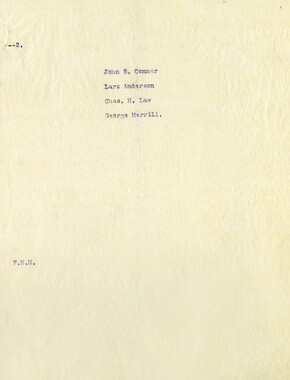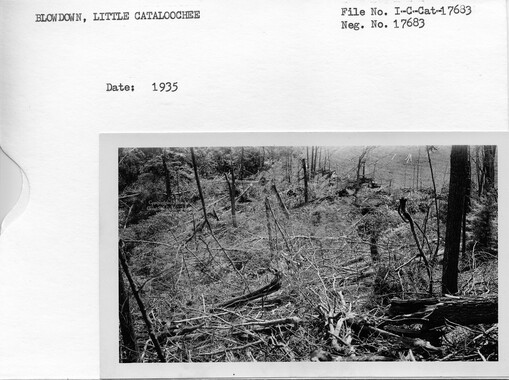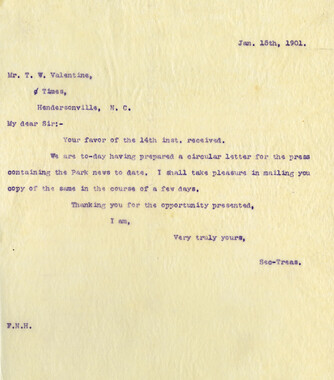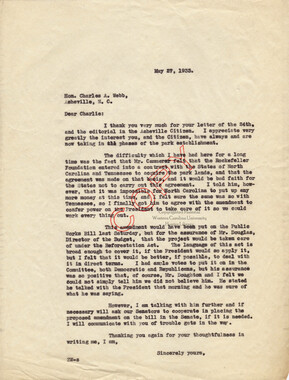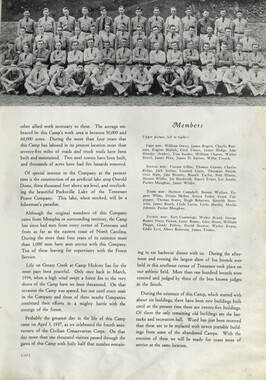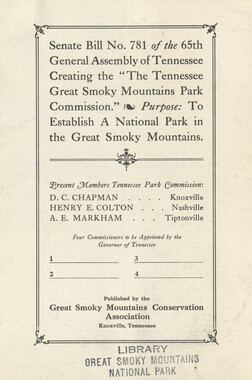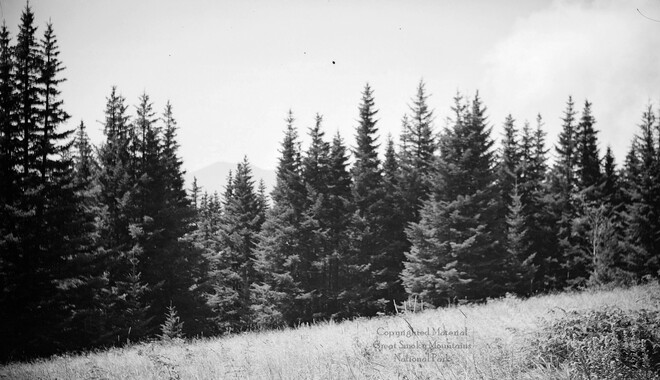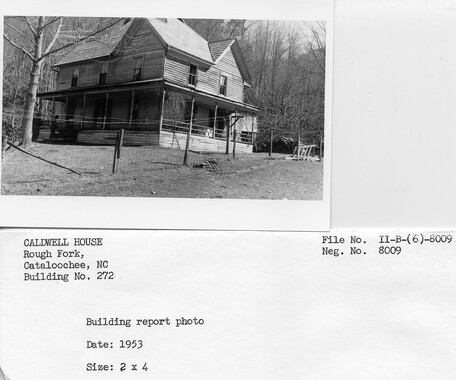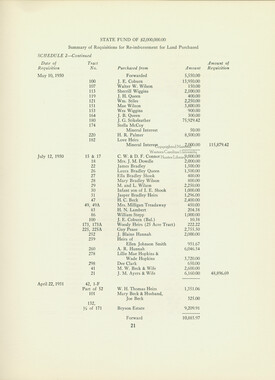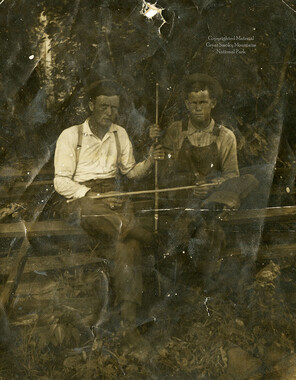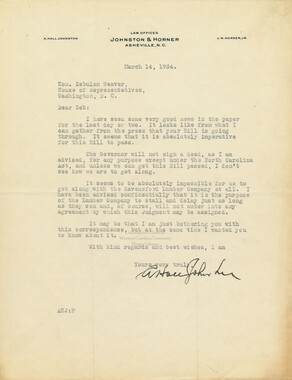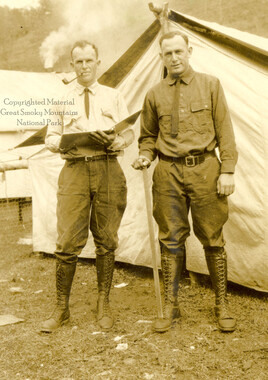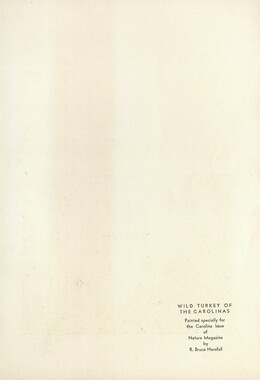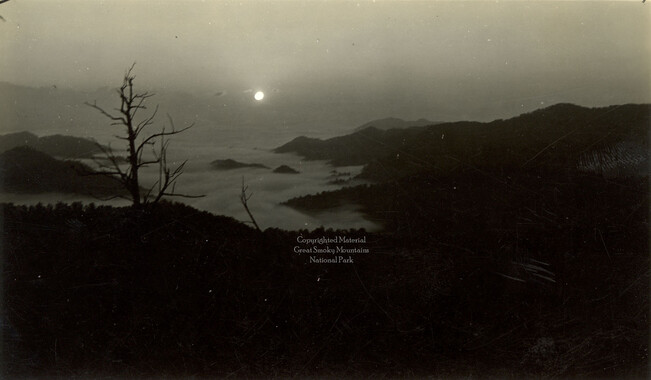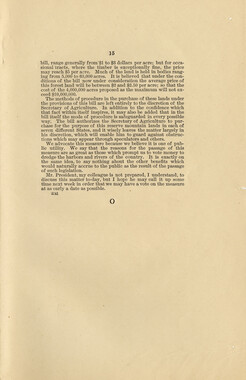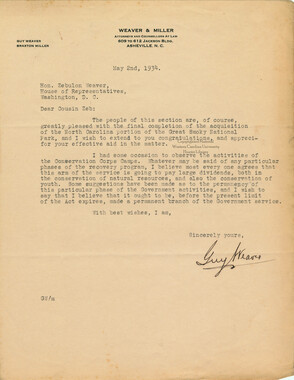Western Carolina University (9)
View all
- Canton Champion Fibre Company (9)
- Great Smoky Mountains - A Park for America (192)
- Highlights from Western Carolina University (1)
- Journeys Through Jackson (12)
- Oral Histories of Western North Carolina (7)
- Picturing Appalachia (3)
- Stories of Mountain Folk (2)
- Western Carolina University Publications (153)
- Western North Carolina Regional Maps (2)
- Cherokee Traditions (0)
- Civil War in Southern Appalachia (0)
- Craft Revival (0)
- Horace Kephart (0)
- LGBTQIA+ Archive of Jackson County (0)
- Travel Western North Carolina (0)
- Western Carolina University Fine Art Museum Vitreograph Collection (0)
- Western Carolina University Herbarium (0)
- Western Carolina University: Making Memories (0)
- Western Carolina University Restricted Electronic Theses and Dissertations (0)
- World War II in Southern Appalachia (0)
University of North Carolina Asheville (0)
View all
- Faces of Asheville (0)
- Forestry in Western North Carolina (0)
- Grove Park Inn Photograph Collection (0)
- Isaiah Rice Photograph Collection (0)
- Morse Family Chimney Rock Park Collection (0)
- Picturing Asheville and Western North Carolina (0)
- Appalachian National Park Association (1)
- Kephart, Horace, 1862-1931 (1)
- Masa, George, 1881-1933 (3)
- North Carolina Park Commission (98)
- Weaver, Zebulon, 1872-1948 (2)
- Wilburn, Hiram Coleman, 1880-1967 (64)
- Allanstand Cottage Industries (0)
- Bennett, Kelly, 1890-1974 (0)
- Berry, Walter (0)
- Brasstown Carvers (0)
- Cain, Doreyl Ammons (0)
- Carver, George Washington, 1864?-1943 (0)
- Cathey, Joseph, 1803-1874 (0)
- Champion Fibre Company (0)
- Champion Paper and Fibre Company (0)
- Cherokee Indian Fair Association (0)
- Cherokee Language Program (0)
- Crittenden, Lorraine (0)
- Crowe, Amanda (0)
- Edmonston, Thomas Benton, 1842-1907 (0)
- Ensley, A. L. (Abraham Lincoln), 1865-1948 (0)
- Fromer, Irving Rhodes, 1913-1994 (0)
- George Butz (BFS 1907) (0)
- Goodrich, Frances Louisa (0)
- Grant, George Alexander, 1891-1964 (0)
- Heard, Marian Gladys (0)
- Kephart, Calvin, 1883-1969 (0)
- Kephart, Laura, 1862-1954 (0)
- Laney, Gideon Thomas, 1889-1976 (0)
- McElhinney, William Julian, 1896-1953 (0)
- Niggli, Josephina, 1910-1983 (0)
- Osborne, Kezia Stradley (0)
- Owens, Samuel Robert, 1918-1995 (0)
- Penland Weavers and Potters (0)
- Rhodes, Judy (0)
- Roberts, Vivienne (0)
- Roth, Albert, 1890-1974 (0)
- Schenck, Carl Alwin, 1868-1955 (0)
- Sherrill's Photography Studio (0)
- Smith, Edward Clark (0)
- Southern Highland Handicraft Guild (0)
- Southern Highlanders, Inc. (0)
- Stalcup, Jesse Bryson (0)
- Stearns, I. K. (0)
- Thompson, James Edward, 1880-1976 (0)
- United States. Indian Arts and Crafts Board (0)
- USFS (0)
- Vance, Zebulon Baird, 1830-1894 (0)
- Western Carolina College (0)
- Western Carolina Teachers College (0)
- Western Carolina University (0)
- Western Carolina University. Mountain Heritage Center (0)
- Whitman, Walt, 1819-1892 (0)
- Williams, Isadora (0)
- 1850s (1)
- 1860s (1)
- 1870s (4)
- 1880s (3)
- 1890s (3)
- 1900s (10)
- 1910s (8)
- 1920s (102)
- 1930s (128)
- 1940s (24)
- 1950s (7)
- 1960s (2)
- 1970s (17)
- 1980s (8)
- 1990s (14)
- 2000s (31)
- 1600s (0)
- 1700s (0)
- 1800s (0)
- 1810s (0)
- 1820s (0)
- 1830s (0)
- 1840s (0)
- 2010s (0)
- 2020s (0)
- Appalachian Region, Southern (5)
- Buncombe County (N.C.) (2)
- Great Smoky Mountains National Park (N.C. and Tenn.) (16)
- Haywood County (N.C.) (167)
- Jackson County (N.C.) (1)
- Swain County (N.C.) (3)
- Asheville (N.C.) (0)
- Avery County (N.C.) (0)
- Blount County (Tenn.) (0)
- Cherokee County (N.C.) (0)
- Clay County (N.C.) (0)
- Graham County (N.C.) (0)
- Henderson County (N.C.) (0)
- Knox County (Tenn.) (0)
- Knoxville (Tenn.) (0)
- Lake Santeetlah (N.C.) (0)
- Macon County (N.C.) (0)
- Madison County (N.C.) (0)
- McDowell County (N.C.) (0)
- Mitchell County (N.C.) (0)
- Polk County (N.C.) (0)
- Qualla Boundary (0)
- Rutherford County (N.C.) (0)
- Transylvania County (N.C.) (0)
- Watauga County (N.C.) (0)
- Waynesville (N.C.) (0)
- Yancey County (N.C.) (0)
- Clippings (information Artifacts) (18)
- Guidebooks (1)
- Interviews (10)
- Land Surveys (102)
- Letters (correspondence) (8)
- Manuscripts (documents) (44)
- Maps (documents) (23)
- Photographs (93)
- Portraits (30)
- Publications (documents) (31)
- Scrapbooks (2)
- Sound Recordings (1)
- Transcripts (12)
- Aerial Photographs (0)
- Aerial Views (0)
- Albums (books) (0)
- Articles (0)
- Artifacts (object Genre) (0)
- Bibliographies (0)
- Biography (general Genre) (0)
- Cards (information Artifacts) (0)
- Copybooks (instructional Materials) (0)
- Crafts (art Genres) (0)
- Depictions (visual Works) (0)
- Design Drawings (0)
- Drawings (visual Works) (0)
- Envelopes (0)
- Exhibitions (events) (0)
- Facsimiles (reproductions) (0)
- Fiction (general Genre) (0)
- Financial Records (0)
- Fliers (printed Matter) (0)
- Glass Plate Negatives (0)
- Internegatives (0)
- Memorandums (0)
- Minutes (administrative Records) (0)
- Negatives (photographs) (0)
- Newsletters (0)
- Newspapers (0)
- Notebooks (0)
- Occupation Currency (0)
- Paintings (visual Works) (0)
- Pen And Ink Drawings (0)
- Periodicals (0)
- Personal Narratives (0)
- Plans (maps) (0)
- Poetry (0)
- Postcards (0)
- Programs (documents) (0)
- Questionnaires (0)
- Sayings (literary Genre) (0)
- Sheet Music (0)
- Slides (photographs) (0)
- Songs (musical Compositions) (0)
- Specimens (0)
- Speeches (documents) (0)
- Text Messages (0)
- Tintypes (photographs) (0)
- Video Recordings (physical Artifacts) (0)
- Vitreographs (0)
- Appalachian National Park Association Records (2)
- Cataloochee History Project (64)
- George Masa Collection (9)
- Historic Photographs Collection (31)
- Horace Kephart Collection (3)
- Love Family Papers (7)
- Map Collection (1)
- Zebulon Weaver Collection (3)
- A.L. Ensley Collection (0)
- Appalachian Industrial School Records (0)
- Axley-Meroney Collection (0)
- Bayard Wootten Photograph Collection (0)
- Bethel Rural Community Organization Collection (0)
- Blumer Collection (0)
- C.W. Slagle Collection (0)
- Canton Area Historical Museum (0)
- Carlos C. Campbell Collection (0)
- Cherokee Studies Collection (0)
- Daisy Dame Photograph Album (0)
- Daniel Boone VI Collection (0)
- Doris Ulmann Photograph Collection (0)
- Elizabeth H. Lasley Collection (0)
- Elizabeth Woolworth Szold Fleharty Collection (0)
- Frank Fry Collection (0)
- Gideon Laney Collection (0)
- Hazel Scarborough Collection (0)
- Hiram C. Wilburn Papers (0)
- Humbard Collection (0)
- Hunter and Weaver Families Collection (0)
- I. D. Blumenthal Collection (0)
- Isadora Williams Collection (0)
- Jesse Bryson Stalcup Collection (0)
- Jim Thompson Collection (0)
- John B. Battle Collection (0)
- John C. Campbell Folk School Records (0)
- John Parris Collection (0)
- Judaculla Rock project (0)
- Kelly Bennett Collection (0)
- Major Wiley Parris Civil War Letters (0)
- McFee-Misemer Civil War Letters (0)
- Mountain Heritage Center Collection (0)
- Norburn - Robertson - Thomson Families Collection (0)
- Pauline Hood Collection (0)
- Pre-Guild Collection (0)
- Qualla Arts and Crafts Mutual Collection (0)
- R.A. Romanes Collection (0)
- Rosser H. Taylor Collection (0)
- Samuel Robert Owens Collection (0)
- Sara Madison Collection (0)
- Sherrill Studio Photo Collection (0)
- Smoky Mountains Hiking Club Collection (0)
- Stories of Mountain Folk - Radio Programs (0)
- The Reporter, Western Carolina University (0)
- Venoy and Elizabeth Reed Collection (0)
- WCU Gender and Sexuality Oral History Project (0)
- WCU Mountain Heritage Center Oral Histories (0)
- WCU Oral History Collection - Mountain People, Mountain Lives (0)
- WCU Students Newspapers Collection (0)
- Western North Carolina Tomorrow Black Oral History Project (0)
- William Williams Stringfield Collection (0)
- Church buildings (5)
- Civilian Conservation Corps (U.S.) (6)
- Forest conservation (1)
- Great Smoky Mountains National Park (N.C. and Tenn.) (7)
- Logging (2)
- Maps (14)
- Storytelling (1)
- African Americans (0)
- Appalachian Trail (0)
- Artisans (0)
- Cherokee art (0)
- Cherokee artists -- North Carolina (0)
- Cherokee language (0)
- Cherokee pottery (0)
- Cherokee women (0)
- College student newspapers and periodicals (0)
- Dams (0)
- Dance (0)
- Education (0)
- Floods (0)
- Folk music (0)
- Forced removal, 1813-1903 (0)
- Forests and forestry (0)
- Gender nonconformity (0)
- Hunting (0)
- Landscape photography (0)
- Mines and mineral resources (0)
- North Carolina -- Maps (0)
- Paper industry (0)
- Postcards (0)
- Pottery (0)
- Railroad trains (0)
- Rural electrification -- North Carolina, Western (0)
- School integration -- Southern States (0)
- Segregation -- North Carolina, Western (0)
- Slavery (0)
- Sports (0)
- Waterfalls -- Great Smoky Mountains (N.C. and Tenn.) (0)
- Weaving -- Appalachian Region, Southern (0)
- Wood-carving -- Appalachian Region, Southern (0)
- World War, 1939-1945 (0)
- Sound (1)
- StillImage (96)
- Text (152)
- MovingImage (0)
Cataloochee: Life in a remote mountain valley
-
This 59-page interview is the transcript of a group of 1981 recorded interviews on “Cataloochee: Life in a remote mountain valley.” The manuscript was collected as part of the Cataloochee History Project that collected photographs, stories, and oral histories about families who lived in the Cataloochee Valley. Today’s Cataloochee Valley is within the Great Smoky Mountains National Park. While, in general, the Great Smoky Mountains region was sparsely populated, the Cataloochee Valley remained an exception. By 1900, the population of Cataloochee had grown to 1,000 residents living in hundreds of log and frame homes.
-
-
. ~·· .. RECORDING of "CATALOOCHEE--UFE IN A REM:Yl'E MOUNTAIN VALLEY" Program sponsored by the Friends of Haywood County (NC) Public Library Grace Episcopal Church, Waynesville, NC June 9, 1981 Dr. Gordon B. McKinney, Moderator Dr. Roy Carroll, Principal Speaker · Raymond E. Caldwell Mark E. Hannah Mary Davis (Mrs. Gldger) Palmer . Dr. Robert Woody Panelists Recorded by: David Dahlen Park Ranger at Cataloochee Speed: 3-3/4 IPS Playing time: Side 1 - 90 minutes Side 2 - 25 minutes LIPR· l?J ov l...ll' • '\. '- l GREAT SMOJ<Y MOUNTAINS NATIONAL PARK Cataloochee KEY This transcript has been made verbatim et literatim as much as possible. There has been NO editing whatsoever. Punctuation is used to indicate the flow of speech rather than follow the rules of English composition. The comma is used where the speaker paused; the period where he stopped; and where there is no punctuation the speaker continued without pausing or stopping. The original (Archives) copy of this recording is on two PAP Industries Inc. C-90 cassettes. The library copy is on reel-to-reel tape, transcribed on a Wollensak 3M 6020-AV tape recorder. The speed is 3-3/4 IPS. The Index Counter Numbers in the margin are for easy locating on the tape. Set the Index Counter at 000 at the beginning of the first voice on each side · of the tape • . The sympbol 1-----1 indicates the transcriber could not understand what was said. . ., Cataloochee C-0-N-T-E-N-T-S Introduction by nave Dahlen Dr. GORDON McKINNEY Introduction of program committee Introduction of principal speaker Dr. ROY CARROLL Locating area on map Early settlement of Cataloochee Residents in 1850 Head of families in 1850 Residents in 1860 Effects of Civi 1 War "Old families" ~gration into Cataloochee The women Ca ldwe 11 family Woody family Palmer family Fate Palmer Jesse Palmer Dr. GORDON Me KINNEY Introduction of panelists RAYMON> CAlDWELL Family members Toys School Recreation Herding stock First trip to Waynesville Raising bees Operating mill MARK HANNAH First match Starting fires Toys: wagon, whistle; whipS First wagon ride First train Affiliation with National Park Page 1 1-5 1-3 3-5 5-26 5 6 7 9 10 10-11 11 12-14 15-16 16-17 17 17-18 19-21, 21-24 21, 24-26 26-27 27-34 35-40 \ ___ ) Cataloochee CONTENI'S - contd MARY DAVIS (Mrs. Gudger) PAlMER Teaching in Cataloochee Number of students First day of teaching Schoo 1 routine "Baby sitting" Bear hunts Dr. ROBERT W ()()) Y Little Cataloochee Uncle Tyne Woody Home Other bui lciings Blacksmith shop Barns Grist mill Apple houses Lumber house Smokemouse Sheep house Italians Tobacco use Amusements Food Salting cattle Criticizing coming of National Pat:k · Spring, water supply Games Berea College Page 40-43 44-54 IN Rt:PL\' JI.EFEll TO: United States Department of the Interior NATIONAL PARK SERVICE Great Smoky Mountains National Park Gatlinburg, Tennessee 37738 N-0-T-I-C-E No part of this · recording or transcript may be quoted or used for publication except upon written permis&ion of the Superin-tendent of the Great Smoky Mountains National Park. ·" (000) (009) Cata1oochee SIDE 1 (No. 1 of Cassette) DAVE DAHLEN Pa ge 1 Following is a presentation sponsored by the Friends of Haywood County, North Carolina, Library, and it is entitled "His tory Is People. 11 This particular program is concentrating on the Cataloochee valley history. BREAK Dr • GORDON B • Me KINNEY Thank you. A number of items that I need to bring to your attention, before we get into the main part of the program. I have ~een asked to request that all of the newly elected officers and all of the award winners BREAK Yogi Bear, had a very significant statement to make about the beginning of this type of program. He was.· receiving an award, and he wanted to express his appreciation to all of the people who made this award possible. But in his awn way of expressing himself he said he wanted to thank everyone who had made the evening necessary. (Laughter) Well. There are a number of people who have made this evening necessary. And I'd like to express the appreciation of the Friends of the I.J.brary, recognize s cme of these people and institutions. The first would be the North Carolina Humanities Committee. They are the people who are providing the basic funding for this meeting. And we have worked very closely with them on this program, and we appreciate very much their financial and other types of support for the prograQJ. Cata loochee Page 2: Now, the project steering comndttee has brought this all together. Chairman of the committee is Dr. c. J. Overbeck who you have already met. I am a member of the comndttee as well, but there are other members of the committee that I would like to have stand and be recognized at this time. The person that probably got you all here was our publicity director Peg Fry (Mrs. K. D.) Peg would you please stand. BREAK The financial officer that paid for all of this in one way or another is Larry Anmons. larry. BREAK Secretary who kept us all from running in about twenty different directions, all at the same time, Polly Ogden (Mrs. Fred). Polly BREAK The people on the comndttee who, par~icularly dealing with Cataloochee who understood their own heritage and the heritage of many of you, and helped the rest of us put this all together, Ernestine Upchurch (Mrs. Cecil) in the back. BREAK (James) Roy Moody in the back. APPI.AlEE And the full time member of the committee, although she refused to accept that position, and especially probably because she didn't want to take any of the blame for what's going to happen tonight, (049) (065) Cataloochee Page 3 and who truly held all of this together as we fumbled around, Katherine Armitage, the library director. APPLAlSE The program tonight will consist of three parts. We will have a main speaker. We will have four commentaries by people who lived in Cataloochee at one time or another in their lives. And then we will have a slide show given by Dave Dahlen, this is not on the program, who is the ranger at Cataloochee now. 1 will give more formal introductions to these, some of these people as we go along. That's the basic order of business. After these presentations we :Will open up the floor so that you can ask questions or make comments, or tell some of the tall stories that 1 heard at dinner tonight from some of these people. 1 am sure that there is a great deal of history about cataloochee, and I have a feeling that I didn't hear any of it tonight. But I heard an awful lot of stories. And I hope that we can all exchange some of these stories as we go along tonight and enjoy the past of cataloochee, what it meant to the people who were there, and what it means to the rest of us who weren't there. Our main speaker this evening is Dr. Roy Carroll. Dr. Carroll is the ideal person to make our main address. He is the author of this particular publication right here, many of you may be fa~liar with it already, "Historic Structures Report, Utt le Gataloochee, North Carolina." He has told me that he will be finished with his writing on Big Gataloochee this August. And that another publication Cata loochee Page 4 on Big Cataloochee will be available in the relatively near future. So that Dr. Carroll is in a very real sense the academic specialist on the Cataloochee region of Narth carolina. He is a native of Arkansas, received his masters degree and doctorate in history at Vanderbilt University in Tennessee, and has served as an Assistant Professor of history at Mercer University in Georgia. Afterwards, in 1965, he became .Professor of History and Chairman of the Department of History and Political Science at Armstrong State College in Georgia. 1969 he accepted the posit ion of Chairman of the Department of History at Appalachian State University. In 1977 he was ·appointed I. G. Greer Distinguished Professor of History at AS u. Since 1979 Dr. Carroll has been the Vice-president for Planning for the entire North carolina university system, and he is now in Chapel Hill carrying out those duties. He has a number of publications on historical material outside of Gataloochee. He is a very well rounded historian. When I invited Dr. Carroll up here to speak, I could hear him over the phone looking at his calendar. And he says "let's see Friday the 12th meeting with so-and-so and so-and-so," "meeting here," "meeting there." Cotmt. These of course are all academic meetings. And I spent a good part of my career attending those academic meetings, and having done so, my feeling that we are doing Dr. Carroll a great favor. (Lau~hter) Far three days, or at least two days, he will not be able to attend an academic meeting, this is a high point I think in almost anyooe's life. He has come however a long way. He left Chapel Hill at 6:00 this (106) (118) (U1) · Cata loochee Page 5 morning, drove all the way up here. And, is going to share ,with all of us -tonight his expertise on the Cataloochee region. Dr. Carroll. APPU\lSE Dr. ROY CARROLL I really came to the mountains to get cool. (Laughter) You not only fooled me on the weather I thought this was a library meeting. I know you're not all Episcopalians. (Laughter) Not that many Episcopalians in Haywood County. (Laughter) Being a Baptist I've never been too sure there are very many Episcopalians anywhere. (Laughter) And I'm sure where they are it's very very warm. (Laughter) (PAlS E) I came up here this afternoon and I very scientifically arranged the projector and the table and the screen so that they would all be in focus, and then Doris Hanmett moves the screen. (Laughter) So you will have to bear with us while we do a little technical work here to get everything pack in synchronization. I will ask Doris if she will to plug it in over there. BREAK - PAlS E I suspect a lot of you are from Cata loochee or you are descended from Cataloocheeans because they were very prolific folks. But for those of you who were not let me point out a few things on the map to you. This is the northern part of Haywood County, a part of Cataloochee township. Take off from Cove Creek and go up what used to be North Carolina 284 Qver Cove Creek Gap and you come into Cataloochee valley. This road right here. This is the Cataloochee (134) (145) · ·'·.~ .... ~ r ,..- ..._._'-'-4 .LVVt....lJ.CC::: Page 6 Ridge. Or Cataloochee Divide. And you come into this valley along Big Cataloochee Creek. One of the main tributaries of it is' Little Cataloochee Creek. Another main tributary is Caldwell Fork. This creek which was for a long time called "Indian Creek" is now called "Palmer Creek" on the maps of the park, because so many Palmers lived there once upon a time. Big Cataloochee then is one community separated by this ridge, Noland Mountain, separated by this ridge from Little Cataloochee. About 1836 or so, the mid-1830s, the first white families moved into Big Cataloochee valley. In 1929, '30, '31, '32, a century later, the Great Smoky Mountains Nationa 1 Park was created, and ~irtually all of the people in Cataloochee township were moved out. They lost their homes, they lost their land. Many of them, til they died, really felt that they were in exile. And in a very real sense they had been moved out the same way the Cherokee Indians had been moved out. They had no choice. I want to trace the, some of the development of that community on the map, and then look at all of Cataloochee township as a whole. The first settlers were the Caldwell family, James and Levi Ca !dwell. Who settled right here, about 1836. They came from Spring Creek over at Madison County. Another one of the families, which came in about the same time, but didn't stay, and came back in later was the Jonathan Woody family. Jonathan Woody's home is this right here. Another one of the early fallli lies, the George (166) Cata loochee Page 7· Palmer family. He and his wife and several of his children came up there in the late 1840s. He came out of Sandy Mush Creek area in Buncombe County, for no great reason to tell you the truth though I'm not sure Linton would tell you, because he was broke. He lost his farm. And the deeds and the records from Buncombe County indicate that from about 1843 to 1846 his small farm was up for sale because he could not pay the mortgage. He loaded his family in a wagon with all his possessions, and ended up in Cataloochee. Just above them, about 1839, a family had settled there the Hannah family, Evan Hannah who, had come up there from Fines Creek. He had .come with his wife Betsy, a house full of children, his father- inlaw William Noland. The Nolands settled on the creek as well. About 1848 also, right here, Yotmg Bennett moved up there with his family. Started his homestead, stayed there for a time. Went back down into the Fines Creek area. And eventually caxne and stayed. So you have these families. You have Bennett, Hannah, Palmer, and here George Palmer's son Jesse Palmer, Levi and James Caldwell, and Jonathan Woody. By 1850, all except Jonathan Woody are living there and they are living there year round. The next generation. their sons and daughters, had moved over the ridge and settled here along Coggins Branch leading into Little cataloochee and here on the tributaries of Lit.tle cataloochee. George Palmer's daughter Ruth married a man named Jack Vess, 1850. He bought this place, in 1853. Was where Will Messer lived when the park was formed, where Ola School was , Ca ta lo oc bee Page 8 and the post office. John Jackson Hannah, Evan's son, marr~ed and moved here about 1857. A small log cabin. Levi Caldwell's daughter Harriet Elizabeth married a man named Dan Cook who came over here from Spring Creek in Madison County. And Dan and Harriet moved here about 1856. Just north of them, Young Bennett's son Creighton who married Levi Caldwell's daughter Louisa Matilda bought a homestead just north of the Cooks. The Cook property eventually ran all the way to the top of the ridge here, and just beyond it eventually settled here was another Palmer, George Peyton Palmer. Pete George as he came to be called later. So you've got a second generation of people clustering over in Little Cataloochee. That small number of families continued to multiply. Newcomers continued to come in. Clustered there. Closely knit. Tightly dependent upon each other. Bound together by affection, by blood, and by sheer necessity. Clustered on the tributaries of Big Cataloochee Creek and Little Cataloochee Creek. By 1929, when the park began to buy the property, the red dots show you how many homesteads and families were there. Here's the schoolhouse. Little Cataloochee schoolhouse. And Ola post office, Little Cataloochee Baptist Church. Down here Cataloochee school, and Palmers Chapel. A post office over here at the Palmer home. And a post office here at Nellie. And by that time down on Caldwell Fork, at the bottom of your map, another schoolhouse which had been built in 1924, and the beginnings of a church there, a Baptist church which was j (196) (197) Cata loochee Page g· meeting in the schoolhouse. Those dots represent several hUndred families. Who had to move when the park was formed. Pause The heads of the families: By the U.S. census records, in 1850, these names appear. Some twenty-four households. I have my doubts about three or four of them. About the Allisons I think they are still in Jonathans Creek though you can't be sure from deeds or from the census, Loy a 1 Ba 11 was over at Mt. Sterling north of Cataloochee. Henry Barnes a young man twenty-one years old. And to indicate the influence of the Caldwells he married a Caldwell. one of the Not James and Levi's families but nevertheless/taldwells from down in Jonathans Creek or Fines Creek. Young Bennett. Here's Henry E. Caldwell who is the son of James and a brother of Levi. These three families. Thomas Ca ldwe 11 I'm not sure of. He is lis ted in the census between these houses so you'd think he was there but I'm not sure about that. Albert . Coggin$ was there as a tenant. Again came out of Spring Creek, Madison County. The Franklin family haQ. ' come up from Tennessee. Incidentally Franklin was married to a gir 1 named Sarah Grooms and you see her faJPily showing ten years later. Here's Evan Hannah. William Jenkins or Norris Jenkins as he was known he also married to a Caldwell. Elizabeth Mcintyre, a widow, who was there from Fines Creek. She is there with two sons but she is not there long, she moves out. She is next door and. living in a cabin that belongs to the Palmers, George Palmer. George Messer who is there briefly, he lived most of the time in (220) Cata loochee Page lD Jonathans Creek but evidently had come up here and had gotten a homestead but eventually moved back and you don't find him again til about 1880 back up here. The Noland family, William Noland of course is the father-in-law of Evan Hannah and Thomas is married to Betsy Hannah. Evan's wife. You've got George Palmer. His son John. And then three Wi lliamsons. The census says Williams but the records, the wills and the other records indicate Williamsons either s-e-n or s-o-n. Both of these, Andrew and Elijah, were sons of Eleanor, she's a widow forty-nine years old. And both of the sons are down on Jonathans Creek within the next four or five years. But you've got that many names and that many family names. Fairly certain in 1850. By 1860 you see the, the new people who have come in. Some stayed and some didn't but what is striking is how many went and didn't stay. Only seven of these family names here which was about 1850 are sti 11 there in 1860 and only these same seven plus one more are there in 1870. Some real turn-over of people in that Civil War period. Because they suffered the same kind of dislocations and depredations a lot of people did in the mountains from raiders and other kind of guerilla activity. Some of them find their farms devastated. Young Bennett's home was burned. His young daughter, sixteen years old daughter named -Sophronia, that's a wonderful name, Sophronia whipped one of Kirk's R.aidexos when Q.e ca.me to their home. I'm not sure whether she whipped him before they burned the house or afterwards. (Laughter) If she whipped him first I can (238) Cataloochee Page 11 understand why he burned it. She hid the trunks and the va~uable possess ions and plenty of some Confederate coins. The Ca ldwells, some of them were killed. Levi Shelton who married to a Caldwell was killed. Billy Caldwell. Levi Caldwell himself, captured by the Raiders in 1864 he eventually got back home, in ill health, he died late in 1864. His father James died in late 1866. In fact by 1870 many of the heads of the families here are dead. Loyal Ball had died • James Ca ldwe 11 had died • Levi Ca ldwe 11 had died. Levi Sutton had died. This is his widow Sally or Sarah. You see it spelled Sutton and sometimes spelled Sitton, it's the same, same name, census man changes it from time to time. 1870 you have hardly ·any more people than you had in 1850. But those were the first families. Out of the family names that appear, in those years, there are some seventeen names which I call the old families. That is you can find them there either in the census records between 1850 and 1870 or you can find them in the tax lists of 1~66, '67, . '68. Those old families you see listed here, still there in 1900 • . This is the surname or the family name caldwell which has been spelled C-o-1, Colwell or C-o-1-d Coldwell. Conard which occasio~lly in the census is Conrad. Cook, Grooms, Hall, Hannah, ~md Harrell or Harold, Hopkins, Jenkins, Leatherwood, McGaha, Messer, No land, Palmer, Sutton, and Woody. These seventeen families account for 86 of the households out of the 137 households in the Township; they account for 505 persons out of 764 there. So there is a lot of the growth of Cataloochee which comes simply from the size of (250) (263) 'ca ta louchee Page 12 the families of those people who settled there, besides just the migration of people who came in. To indicate something of the migratio~ and where there. The total population in 1850 was about 140, maybe 147 at the most if you count all the names I have on the other list; then 161, 198, it nearly doubled within the next ten years to 391 and then 764 in 1900. In fact between 1870 and 1910 when there was something over twelve hundred people in Cataloochee, cataloochee Township, there was a six-fold increase in the population. So what you had in cataloochee was not a stagnant sort of mountain community but a - very thriving flourishing kind of community. Growing. You see the origin of the people, ~t of them native North Carolinians in each of the censuses, the next largest group from Tennessee as you would expect and then a scattering from other places, one man from Pennsylvania, in the course of this period, one man from Georgia, two from South Carolina, one from Canada, one from England, but most of them North carolinians. In age distribution you see gradually that the population is getting a little older. It's a more settled and stable community obviously. And you are finding more people by 1900 who are past fifty years of age. Most of the occupations as you would suspect they were farmers, they were lis ted as farm laborers or day laborers, or if they were housewives or daughters of the family list.e~ as keeping house or domestics, but beyond those which account for most people you have a smattering. You have a carpenter a couple of times. A man (l. 76) ,,,. 'ca.ta loochee named John Mull who was a mechanic and a carpenter living with Levi Caldwell in 1850, for example; a chair maker named Alfred Rains who moved in there later from Tennessee. Four ladies who called themselves dressmakers, by occupation in 1900; one grocer up on Big Creek; one lady who calls herself a midwife but there are at least three midwives in there Betsy Hannah being the best known one and then Mark Hannah's mother I think after that. One master named Hall and many of you know who that is. And a teamster, that Canadian named John Ewart who lived up on top of the ridge between Big Cataloochee and Little Cataloochee. So what you essentially have is a rural community, simple in its economy, and because it's simple in its economy you don't find any distribution of wealth. You don't find any great radical social differences between the people, obviously some better off and some worse off. And if you look at the next chart you see something of the nature of the society. Most of them are farmers. Those who owned their farms you see in the first three rows, 18 of them in 1860, 44 of the.m in 1880 and 67 of them in 1900. It's interesting most of those are old families. They are not the newcomers. More of the newcomers are renters. The farmers who rent the farm that they're on, nearly doubled between 1860 and 1880 but it remains fairly stable. The largest growth is in those people who rent a house and they are day laborers for somebody else. Most of them are migrants but not all of them. Some of them are younger sons and yotmger daughters of ,~ · - (291) ·cata loochee Page 14 families that are there. The good land is gone. There's not enough land in Cataloochee to provide security and prosperity for each succeeding generation. And you divide it up among your heirs and then your heirs divide it up among their heirs and you make provisions for all your sons and daughters and the good land is gone. More and more of the young men have to leave the valley. Some of them go for an education. Some of them go to seek their fortune. Some of them go because they fell in love, a lot of them. But they had to leave the valley. They could not stay there and raise their families. And it's striking that among those people there in Cataloochee by 1900 that the average size of the farm is getting smaller and smaller. Simply because of that successive division of property among heirs. And the increased number of tenants and day laborers that you see reflect some of all of that. There's one grocer as we said, one teamster. There are these for whom no occupation is shown. But you get something again of the development of the community and the changing ·pattern within it. It clearly was a society dominated by the men. If you look at the heads of the families, in each succeeding census, you'll see most of the heads of the families fall between twenty and forty. Most of them are male. Only one female is head of a household this year. Then there are four, then suddenly there are nine, most all of them widows but not all of them. Some of them unmarried. And then you have in 1900, overwheLmingly male heads of the household. That's to be expected. (297) cataloochee Page 15 But when you look at some details about the women in the society you're in for some surprises. In 1900: 115 mothers. They'd borne 615 children, an average of five or six each. Suddenly one of those children has died; 544 of them still living. Out of that 115 mothers, 37 of them had lost children. That's a surprisingly low figure. Given the fact you don't have doc tors and hospitals and pediatricians. Just one year my understanding (Laughter) But 78 of those mothers all of their children were still living. They've not lost any. You see the size of their families, a number of mothers with one child or two or three or four or five or six as I said most of them fall somewhere in this range on the average. But there were some with thirteen, some with twelve, eleven. The largest family I've found in there was Evan Hannah's household in 1880 there are nineteen people living in two rooms. Jesse Falmer He wasn't far behind. once had seventeen in his house though.~he number of married women reporting no children, twelve. Of that twelve three of them had just gotten married. Three others had been married two years or less. The age when they married, twelve of these women had married between ages ten and fourteen. Thirty-seven of them between fifteen and seventeen and so on. The average age, the median age I suppose to use the right statistical term, was about nineteen, which is older than most people would suspect. Interest-ing enough: when you go back up here and see there are 71 children who died, nearly two-thirds of those children who have died were children of these twelve mothers. The two who had married when -. ·;; ·"!T'·'~~"~:'n':';::!;ft~'!"- •~:· "'>!"-'"'~..:- . .:. , ca ~ a 1oocnee Page 16 they were ten years old, one had had eight children living and seven who had died, the other had seven living and seven dead. Most of the rest of them if they married twelve or thirteen or fourteen they had six or seven living, six or seven dead. But one of the girls who married when she was thirteen had, 1scuse me, one of them had been married when she was ten years old had thirteen children and all of them still living and she was thirty-six at the time. Her name was Sutton, the Suttons were healt;hy. (Laughter) The age of the husband when married: you see they are older, and in fact the median age for them is about twenty-one almost twenty-two. But I was struck by the, by the number of mothers who had all the children living. Those midwives must have done something right. They knew how to take care of those babies. And it really is a startling statistic. Good mothers too that's right. Somebody said helpful fathers. (Laughter) When is Father's Day? Coming up. (324) Let me go this way first. The Caldwells. Let me go back I skipped one. I don't blame Doris for that one I just skj.pped one. (328) Here are the first Caldwells. James married to a lady Mary> I don 1t know her last name. Their son Levi married ·to Mary Ann Nailan. Sometimes the census says N-a-i-1-i-n-g, sometimes N-e-y-1-a-n-d, but the most frequent spelling in those years was put here. A daughter whose name I don 1t know. Their son Henry who moved into Cataloochee wHh them and his wife Matilda. They eventiJally moved out. A daughter againwhos.e name I don't know.- The son Reuben 'l ..• ~K • (333) (342) (344) ·CaUJlooch ee Page 17 who l ived there for a time, he was there in his father's ho~ehold when they moved up there and then moved out, Alfred, the same way who married a young lady named Elizabeth Boyle. And then Louisa. on the Woody side. This is Johnathan and this is a misprint, that ought to say Halinda I would blame that on my secretary Hugh except I proofread it I wouldn't blame her for it. Malinda Plerraoons. And then the son William who didn't come into the valley with them. A daughter Martha Jane. Son known as Tyne, James Valentine bor~ on Valentine's Day 1846, married first Louisa Matilda Caldwell Bennett, Creighton Bennett's widow, and later Laura Hannah. Susanna Woody who married Harrison Caldwell, that's William Jarvis Harrison Caldwell, who is this man's son. Louisa is his daughter. Nancy J. or sometimes the records say Nancy A. and I'm not sure, Nancy A. may be more accurate. Lucinda E. An4 Stephen L., Uncle Steve Woody that most of you who lived up there knew, who married Mary Elizabeth Palmer who is Fate Palmer's daughter we\11 see in a moment. And Robert Jackson or Jack Woody. And then Rebecca Woody. In one census she's called Rachael I don't know whether she only had Rachael or another Rachael but Becky Woody is what most people knew for her name. PAlEE The first Palmers. George Palmer married Polly Starrett, her father was Alexander, they were neighbors over in Sandy Mush in Buncombe County. A son William who left in 1841 'to go to Mexican . war. Written in the family Bible is a really painful statement (353) (355) (357) . ca ta loochee Page 18 written apparently in his mother's hand that said "this day! William Palmer left for Mexico," And they never saw him again, I think he ended up in California. Ruth Vess who married Jack Vess or Vest V-e-s-s is the most common proununciation, in 1850 and they settled there on Little Cataloochee, Julia Carolina is in the household and stays there til she dies in 1878. John Alexander who married Minerva Caldwell I don't know what Caldwell from Jonathan Creek or Finelj Creek but eventually he moved back down to Fines Creek he didn't stay this decade, Polly Ann who married Allen Noland from down on the mountain, Jesse Palmer or Jesse Richardson who married Mary Ann Rogers or Polly Ann Rogers. And their baby son George Lafayette who became Fate Palmer or Uncle Fate Palmer who married Nancy Jane Caldwell and Nancy Jane Caldwell is this man's daughter. So you've got the first generation. Now we're not going to read all these names and identify all of them and tell you who they married, but I want to indicate something of the size of the family. The original George Palmer's baby son George Lafayette and Nancy Jane Caldwell had these children~ one, two, three, four, five in the 1860s, one, two, three, four, five in the 1870s, and two in the 1880s. Jesse Palmer his brother and Polly Ann Rogers or Mary Ann Rogers, have these, two in the 1850s, six in the 1870s, and four more in the 1870s, in 1860 and 1870. Then on the 'i...c!vi and Mary Ann Caldwell these children. Now almost all, well in fact all of these stayed (369) {373) in the valley except this daughter Mary. She was born in 1864 and from everything I can gather she must, her mother must have been carrying her when Levi died. And she shows up in the first census in 1860 and then does not appear again. I think she must have died young. The family record says nothing else about her. Not all of these stayed in the valley to be sure. And not all of these. This is a son Jesse, married 1-----1 in 1873 and from what I can gather died about two years later. But I put him in here because by her obit ua.ry as we 11 as by the records and the census ret urns by 1900 the reports that she has twelve children all but one living, and her obituary later says she's that she had twelve children and one those, this is the only one I can account for/named Jesse Lewis. And the Woodys you saw a moment ago. For Jonathan's family. Now what I'd like to do for a few minutes. And we can have the lights on if you will. · Is to really concentrate on two men and tell you something about those two men to give you some idea of Cataloochee and the development of the township particularly Big Cataloochee itself. Those two men are George Lafayette or Fate Palmer and his brother Jesse. From those two, all of the Palmers were descended. Those two brothers who stayed in the valley. Fate Palmer was born in 1836. When his father died in 1859 he was not quite twenty-four years old. But here he was, his oldest brother had left. He had a widowed mother fifty-nine, an tmmarried sister living in the household, Julia who is thirty-four. A young cata l cwche'e Page 20 I man named Henry Mcintyre, the son of that widow Elizabeth Mcintyre. And a young mulatto servant named Nancy Casey. I've only found two blacks or two mulattoes in the whole hist_ory of Cata loochee, one in the household of that Henry C., Henry C. Caldwell that I showed a moment ago and this Nancy Casey. I don't know who she is. She doesn't appear again. Before the end of that year 1860, Fate married Nancy Jane Caldwell. There were few people to work on the place as brother Jesse had already married had already set up his awn household, up on Indian Creek. He had to face the dislocations and the deprivations of the Civil War. The cash value of his farm was cut in half between 1860 and 1866 by the records. His brother Jesse suffered the same fate. In the tax list from 1866 to '68 the value of the property was way dawn. In 1870 census he's had five children, he still had his mother and sister there, he has a nine-year old daughter, a nine-year old girl named Martha who was the daughter of a Henry c. Palmer that I can't identify but he was killed in the Civil War in 1861. There's a picture of a Confederate soldier in some of the records that Unton Palmer has, I don't know who he is unless he's Henry c. but I can't locate him. But there 'is a daughter named Martha who is there. And Young Bennett is the administrator or the Executor 0£ Henry C's estate and on one occasion I find a record where is paying her off in Confederate gold coins as part of her inheritance. A young man named Tolbutt Kerr is living there as a farm laborer. So he had a large household. By the agricultural census the value of his farm was about five .. (390) (392) (395) hundred dollars then, it had been twelve hundred dollars in .l860 • • He had 81 head of livestock, that year he had 300 bushels of corn, 300 pounds of butter, seven tons of hay, among his production. His brother Jesse was doing better. By this time by 1870 Jesse has nine children and his wife, his farm was worth a thousand dollars, he had 75 head of livestock, 200 bushels of corn, 300 pounds of butter, three tons of hay, and 700 pounds of honey. (Laughter) Between 1870 and 1880 Fate Palmer bought 250 acres of land, additional land. His mother died in 1878 and left him fifty more acres and the livestock and the remainder of the property the .kitchen and household furniture that his father had left. His sister Julia died in 1875 it was. She didn't have a will her estate BREAK (End of Side 1 of cassette No • . 1) (396) \.JU'-'-" .&.\JlJ-.1.&-'- (Side 2 of Cassette No. 1) In the next decade between 1880 and 1890 he bought seven more tracts of land and had two more children. By the end of May 1889, now this is, this is a young man who came up there with his daddy in a wagon, with everything they owned, and in his daddy's will in 1859 among the household possessions left him is a clock. We'll come back to the clock in a moment. By the end of May 1889 Fate Palmer had inherited or purchased 1,031 acres of land in Cataloochee. Only fifty of which he'd conveyed to a son, George. So he still had 981 acres of it. From then til 1905 he purchased seven more tracts of 327 acres in Cataloochee and Little Cataloochee and 364 ·acres in four other townships, Fines Creek, White oak, Ivy Hill, and Jonathans Creek. During the 189~ he and his wife began to provide for their sons and daughters. Especially for the sons. In the 189~ he conveyed 277 acres of land to his sons, in addition to the fifty he had already given to George; 85 more to George on Davidson Branch; 60 more to William on Double Branch; SO on Davidson Branch and 75 acres on Snake Branch to his son John, and 15 0 acres on Cata loochee Creek to his son Harley. In 1900 census he and his wife, his daughter Maria, his daughter Polly, his son Harley, and his son Jarvis are still living in the house. At the time of his dea:th in April of 1910 he still held 881 acres in Cataloochee Township and 364 acres in those other four townships for a total of 1,244 acres. That's beside the 477 acres that he'd already deeded to his sons. The man was doing well. He was very (4U) (416) · cata loochee Page 23 careful. As his father had been careful before him. And wHen you trace through his dealings you find that there are about three different strains that run through what he was trying to do. And he is in fact the richest man in Cataloochee. At that time. One thing, he tried to keep the land in the family, his wife had land that she willed, his mother had land that she willed to a niece and a nephew. He bought it back from 'em. His sister Julia's land he bought it most of the shares and interests from the heirs. His brother Jesse's heirs divided nine tracts of land when his brother Jesse died in 1896 and Fate Balmer bought one of those tracts. His brother John who had been up there in 1850 and left and went down to Fines Creek, he bought that place from John's widow and her daughter and son-in-law later. He tried to keep the land within the Balmer family. They were also careful to keep to make wills. His daddy had moved up there and like most people who moved up there they didn't take out title to property they didn't buy it, they moved up there and homesteaded and later they bought the property. But he was careful, his father was careful to make a 11 the deeds and get a 11 the deeds ,recorded late in 1858. And two days after he recorded all the deeds he made out his will. And the property 9asn1t divided the property all went to Fate. When Fate died Fate had a will. When Fate's son Jarvis died Jarvis had a will. It makes all the difference in the world in what happens to the family property in that kind of society. He made an effort in the purchase and in the conveying of the land to make provisions (422) (425) (433) cata loochee Page 24 for his sons. He also was very careful when he loaned money to friends and neighbors and he often did. But in the courthouse there are records of chattel mortgages, where if it's a particularly bad riskJthe lady who needs to borrow fifteen dollars has to put up a red caw as security, or the man who borrows fifty dollars puts up a black horse mule for security, or another man puts up a sow and five shoats for security. And sometimes mortgages of Land. When he died in 1910, his property was divided by the teriiJ3 of his will to his children. His daughter Maria got 100 acres. She was to care for her mother Nancy Jane. Nancy Jane his wife his widow was to get his mare Daisy. His son George got another 125 acres of Land next door to Andy Bennett's land. His daughter Jane got the west side of a 100-acre tract in Dellwood incluiing a storehouse and a lot and fifty dollars. His daughter Polly Justus got the other part of that tract and gold. That's John got a SO-acre tract. Mary Elizabeth Palmer, Steve Woody's wife, got fifty dollars and the Smith place. laura Jarrett got $150. All the rest of the heirs were to divide that property down in White oak after Nancy Jane died. Jarvis got the old home place, the Fate place, the John place 258 acres along the creek and he got 300 acres over on Deep Creek and Martin Branch up above Mack Hannah's place. Jarvis, Harley, and Maria got all the personal property. Now what about his brother Jesse. Jesse was without any question whatsoever the most prosperous and the best farmer in the valley. Let us simply indicate to you by 1880, he has 213 head of livestock, .~ .. .•. ' · ... cata loochee Page 25 seven horses, two mules, seven milk cows, 57 other cattle, 65 sheep from which he got 110 pounds of wool that year, 75 hogs, 100 bushels of wheat, 800 bushels of oats, 800 bushels of corn, 40 pounds of tobacco, 900 pounds of butter, five bushels of flax, 100 gallons of sorghum molasses, 300 pounds of honey he has evidently got rid of some of those hives. He has opened two orchards, an apple orchard and a peach orchard. He had 120 dozen eggs, he cut SO cords of wood. In all Jesse purchased between 1858, or 1857, and 1894, he purchased 1,003 acres of land in Cataloochee. He sold 456 acres of it at a nominal su~to his brother or to his sons. When he died in 1895 he didn't have a will. The co~ssioners divided his land into nine tracts. One 85-acre home tract went to his son Thomas. Eight others went to daughters. But one of those daughters deeded hers to her 100ther and her mother turned around and deeded it to Thomas. one of the tracts one of the daughters sold to Fate Palmer, Uncle Fate. One of .them, the daughters sold property to Frank Palmer. One of his sons Robert James was not provided for in his wil 1. I do not know why I don't think he was mad at him. But I haven 1t found in the deeds where any property was conveyed to him earlier than that. Some of you may know the story behind this but I don't. But his heirs also kept the promise that he had made to his son-in-law Dr. Caldwell. Doc caldwell, he promised him fifty acres, and they they provided it for him. And a 1~-acre Chapel tract that his wife wanted deeded to the Palmer/Methc;xlist Church as it 1 s known now. ,.,,. (447) .,.,_. >[•'• · · ~ .. ' · Cata loochee Page 26 well those two brothers, they were the leaders in the ColTUilunity in so many civic ways. Election judges, school corrnnissioners, justices of the peace, school census takers, road trustees, list takers, tax assessors. Jesse in particularly extremely active in the Methodist church. He was appointed to the Board of Stewards, the Conference the of the Methodist Church in/!8701 he was selected by the quarterly conference as a delegate to the District Conference in 1875 and '76. His sister Julia had given the first land for the first church and schoolhouse there, his wife Polly had given the land for what's now Palmers Chapel. Those two men represent something of the very best of the history of Cataloochee. Really remarkable. And let me .stop right there. Simply by saying that I stop in 1900, for two reasons. One the census records after 1900 aren't available, and if you want to see the ones for 1900 you have to go to Atlanta. But there are people sitting here who've been there who lived there after that and know far more about Cataloochee after that than I'll ever kn~. And I' 11 simply defer to them. Gordon. Thank you. APPIAl.SE Dr. GOH> 00 Me KINNEY The next part of our program is so1jl8thing that we feel can be very special. As Roy Carroll has described there were several older families that were extremely important part of the history of Cataloochee region, and we have representatives from several of those families here with us tonight. They are going to share with us their memories of life in the Cataloochee area. There are three -_ ... ·~· · . · Cala loochee Page 2 7 people here who live still in Haywood County, Raymond Caldwe.ll, Mark Hannah, and Mary Davis Palmer, and, our fourth member of the panel is or. Robert Woody from Durham, he ha8 taught at Duke for many many years. We would like to especially thank Dr. Woody, he drove up here hinself from Durham and will drive back tomorrow, doing this all not only on his own time but I might add in this time period of grants and reimbursement and so on on his own money as well, and we deeply appreciate his contribution here. These people will speak to us in the order that I have introduced them and also in alpha-betical order, the only order that they would agree on. Mr. Caldwell. RAYl-I>N> CAlDWELL ) Sometimes it's not really the best to have a name start with law in the alphabet, but we did agree to this and I'm. After listening to Dr. carroll I'm sure glad t~t somewhere along the line, Aunt Jane I Caldwell married a Palmer cause I'm glad to know (obliteratwd by laughter). , I thought the ca ldwells was outdoing the Palmers all this time over there but I'm going to have to change my mind on that. ) Dr. McKinney wouldn't give us a topic to talk on, and I'd a like to had a topic maybe last week or something but that wouldn't have been exactly right I couldn 1 t have read my notes and , talked anyway if I'd had them, outlined it. He wanted me to talk a little about the life, growing up on cataloochee. ....... C<.tt<J.loochee Page 2·s Hell. You saw the history of the Caldwells and the Palmers 'I'm a great grandson of Levi. I was born along with seven of my brothers and sisters in the Uncle Jesse Palmer house that he mentioned. All of us was horned in the same bedroom, attended by a midwife. Some of the later ones, of my younger brothers, had one sister. Doctors were available at that time but they lived in Waynesville and by time you got the message out and they got over there iL was too late. (laughter) So a midwife took care of those cause I can remember very distinct my mother sending me to get the midwife to tell 'em what was a happening, and for her to come. And my youngest brother was horned in 193 7, on the 11th day of May, and I went to Uncle ·will Palmer's house and his wife Aunt Ellender, they were just beginning to start to plant corn. She said 'well I guess I can go, can you help Will plant corn?" I says "I sure can" I wasn't but about twelve or thirteen years old but I I planted corn all day and come in and ever'thing was fine 'at home. An' I'd again, tell you that the midwives did a good job. Life I guess as a youngster on Catalooch was about like it is any other community at that time. With the exception that, we couldn't run dawn to the hardware store or over to the general store and have the things that normal boys and girls did a grawing up, toys, we made our toys. I can very we 11 remember making wagons. Going to the woods and finding a good black gum tree that was about twe~ve out or fourteen inches in diameter, and cutAhe wheels for a wagon, rather than to drill a hole in the wagon wheel with a, an auger or (490) (493) (497) .. __ Page 29 a ship auger, some way to get it open we'd just go to the biacksmith's shop and put a piece of iron pipe in the, in the forge and heat it up and burn that hole that made the thing run better anyway. Anyhow I went to a one-room school. You'll hear more about that I think from Mrs. Palmer when she gets up here. I think I had to go to school to her three years. (Laughter) And the the worst the worst thing about it was I couldn't get by with much at school because she was a board in 1 at my parents' home (Laughter) so we didn't we didn't get by with too much. I don't think we would have . been able to g~t by with much anyway. For entertainment I guess we did about the same as most children wou1d do. We had different games to play. Course Mary would introduce some new games along maybe we hadn't heard from from out in the big world. And. We had our different games at home but we didn't have a lot of time to play, cause living on a farm, they was chores to do. We had livestock and we had to, barn full of corn that had to be shucked every winter 'n', taken care of and all the crops to take in in the fall of the year. But one of the highlights of, I guess for us youngsters in the spring of the year was when Litton Balmer's father and my father and Uncle Harley and Uncle Will and all these people that had their livestock they had free range out in what we called ''The Ledge." That was west of us back out where .the Suncrest Lumber Co. had cut loochee Page 30 ) the timber and had the balds, grassy balds and we'd range our cattle out there and we'd get the cattle rounded up and get the horses out and saddle them up and go take these cattle to the mountains and spend two or three days. Of course we'd take the fishing pole along or we'd cut us one along the way and trout fish and just have a good time. And then again in the fall of the year when we laid the crop by that was another outing that we had. (502) But, going to a one-room one-teacher school I guess is a little unique. I don't know whether it was the teacher's fault or was the student's fault but I spent eight years a getting through seven • grades. (laughter) I told Mary I thought it was the teacher's fault. But anyway that's what happened. And. The teacher would call the class of the first grade or the second grade whatever she would want up front at her bench and she would teach that group whatever there was and the rest .of us would be in a 11 kinds of meanness if we could get by with it. And that went on til she'd covered all the grades from all the different subjects that you were studying and I don't know rittin' ritin' readin' and rithmetic. I guess they migbta been little more than that but that was basically. And, the best I can remember, from the first grade through the seventh grade, they was never more than twenty, fifteen, twenty, maybe twenty-two students. When I graduated from the seventh grade in 1937, they was three of us in the class, myself and two other cousins that were sisters. They was, I believe fourteen ar sixteen in the tota 1 school. But for some reason or other they accepted us :n. (512) (518) Cataloochee Page 31 in high school. We moved out and. Well we had to come out ,and board the first couple of years we 's in high school before the family moved out. And, of course we, being in a family of eight children, seven boys and one gir 1, we would get to playing up on the mountain and different places and of course mother had a lot of problems with us falling out of trees, down on rock cliffs, running into barbed wire fences, and we 'd get in a little feud every now and then and somebody would get a rock throwed at 'em and get a cuttin. She would have to bring us out of there or ca 11 a neighbor had a car and my father was away at times and she was just there with us by herself and my grandmother lived with us but, anyhow she managed to get us all through. We are all living in Haywood County. All the boys went to some branch of the service. And none of us got any disability, we no one of us got any scratches I guess during that conflicts that we've had since 1942 or '41. The first that I can remember of being in Waynesville, well the first time I can remember coming across the mountain I come in a wagon, over to Cove Creek. And then of course back the same day. But coming into Waynesville the first I can remember was when they was tearing down the old courthouse, and that must have been 1930 '31 and the old red brick a falling and the dust a boiling up. SO we didn't come to, my parents didn't come to, into town maybe twict a year, for just the essentials. Cata loochee Page 32 (522) And Dr. Carroll was talking about all the bees that Uncle Jesse Palmer had, he must have left some of them there because the first time I can remember my daddy had about fifty stands. And course we had to take a lot of honey off then, and people was in there and out and I believe we got about fifty cents a quart for it something like that but we did sell a lot of honey. And. Our basic income as he has mentioned was livestock and some tobacco I don't think we ever had four hundred pounds of butter because us boys would eat it faster than that. (Laughter) Never did accumulate that much butter. But honey we might have accumulated quite a bit of honey. (526) #But, as I say my father, his father bought the Uncle Thomas Palmer place, Uncle Jesse place as Uncle Thomas had other, in a, I think it was about 1922. And they was a grist udll on this property that I would imagine Uncle Jesse built. And, I know that when the people would come to mill on Saturday bringing their little half a bushel or bushel whatever corn that they needed to grind into cornmeal to do them that week, if Dad was busy or if he was out some one of us boys would go grind this corn for these people. And I can remember Eddie Woody coming, he always come up llttle Catalooch, and he would be at the mill at daylight on Saturday morning with a half a bushel of corn. So it come my lot to go grind Eddie's half a bushel that morning the first thing. And I went up there and of course I had to get Eddie to help me open the, had one of these old tub mills with a what we called a forebay it wasn't a thing but a tank and you had to raise a big lever up to open the water to go in (540) Cata lo ochee Page 33 down a chute to run this turbine wheel to run the rocks and \grind the corn. And I got Eddie to help me do that. Got his half a bushel of corn poured into the hopper and the mill started. The rock started and here come out some of the most mildewed moth looking cornmeal you've ever saw, and of course what had happened: someone during the week had needed to grind a little malt to make a little moonshine so they could transport that corn across the mountain (laughter) to make a sale. And course that malt come out of there that ruint his meal. And, Eddie stuttered a little and I I just don't know what he said but he had quite a lot to say (Laughter) about those bootleggers a getting in there and messing - things up. We 11 what I did, you could take and what we ca 11 bent in the rocks, we had to clean out that malt, that moulded meal and then grind another half a bushel on the house to get it bedded d~n so we could, and put another half a bushel in for Eddie to send him on the way to make him happy with his, with his cornmeal for that week. But I do remember that real vividly. Then on Saturday sometimes they would be all day people comingJit would take all day to grind what people come and especially in the summer time when the water was low and you couldn't divert enough water into this forebay and tank to keep the water level in it enough to run the rocks as fast as you needed to run them to get the grinding done sometimes it would take thirty minutes to grind a half a bushel of corn it run so slaw. But, we had a way of doing that. And I doubt if I ask the question does anyone here could tell (547) (552) Page 34 me how we brought the level of that water back up in that forebay. That leaked. It was put together with boards and of course it was old, built about 1860 I guess or 1840 I don't know just when but. The only way we knew that my dad showed me to do, we was in the right along the creek bank and if you know where the mill was at there that mountains on each side a lot of laurel and so on and hardwood timber. So we'd just go up in the woods, rake up a big armful of leaves and throw into that race and pull those leaves into that hole, stop up the water from escaping and bring the level of that forebay up ti 1 we'd go right on. Anyhow that's basically the life that we lived and we enjoyed it, and today my father is still living he's eighty-six my mother's eighty-four, she still does all of her housework and she gave birth to eight boys, or seven boys and one girl, a 11 attended by a midwife except my oldest brother, and he was born in Swain County. And she's in good health for an eighty-four year old, my father is in good health for an eighty-six year old, and~ I don't think you can go wrong by being raised up in a primitive area and so. Maybe we didn't get the chance to get out to get an education that we needed but we survived. Thank you. APPLAtBE ; ·-· ~'~,-~~:/~~:}ft~t~' '' ., __ ... ,. " ·:,··; .... .. . Cataloochee Page 35 Dr. GORD ON Me KINNEY (553) Our next speaker will be Mark Hannah. MARK HANNAH (554) I'm 'fraid I'm not much of a speaker cause I'm kinda hoarse. Anyway I'm the old fellow came up over in Gataloochee too like Raymond, and about all I can tell you'd just be sayin' he 's really passing it out to you just as it was. I can verify that. (555) But we had a lot of fun when we were boys, messin' around over there as he said we'd get out, go to the woods and. I 's an awful boy to hunt. I'd get out and squirrel hunt, things like that; have ·some place to go. And I grew up on a farm 'n 1 • We sometimes had a little fun. Stock, got in around places, bringin' 'em in from the fields 'n', bring 'em to mil~, get out the caws an' milk 'em that was one great big job we had to do. It had to be done morning an' evening too, get ready to go to school. But. (560) one of the things that U8kes me remember, a few things the old; way back when I was just a little boy. Was~ My grandmother w~s living with us 'n', we heard somethin' bein 1 brought in, something new. And we got to inquiring what it was. Granny said that she had heard it was a little old stick that long . and said you could rake that thing over a rock and it would explode. She said "I tell you that •s something dangerous." It was called a match. (Laughter) 1----:-1 too dangerous to fool with those things they explode. (Laughter) She would really get after us if she found us with a match in our pocket. (564) (569) (572) Cata loochee Page :36 Well I guess you wonder what we done before that, before we got the I matches for fire now that, that was something. You had to keep fire. Build aw everybody had chimneys of course at that time and they burned some kind of wood usually hickory was the best to keep fire. You covered that up of a night. That burned good and get a coal on it cover it with ashes so it wouldn't get much air. Next morning you just rake that off, start your fire up with some dry wood. But if you lost that thing you 's in trouble. If your fire went out during the night. I remember one time, I was bein' sent over to my grandmother's. I believe one of the other boys with me but I'm not sure but I remember we had a pot 'bout this big build ·a fire. Said "you take that and go over to Grandmother Hannah's and borrow some fire. We've lost our fire here. 11 We went over and sure nuf she gave us some fire coals and put •em dawn in the kittle an' ashes an• went over and came back home with the fire. That's the way we got our fire started. 'Ulter on we got up on a little better on that deal •n•. We got to wondering if we was out in the woods what would we do. How would you build a fire out there? Well I 's out with one old fellow. He took some, bullet out of a shell he had. That left the powder in there 'n' then take and put a dry rag. He fired that gun and the little rag caught fire 'n'. He started the fire with that~ ('Ulughter) Another way was we had dry piece of wood that we called punk come out of lQcust usually, dry locust. It looked like a piece of c;ponge. And if you .keep that good and dry and take a flint rock. Then take a (577) (580) (582) .. , .. . ·;: Cataloochee Page 37 knife an' strike it thataway a spark would fall out then you set that under there and it would catch that punk. There's nothing hardly so dry that we ever heard of as that punk to start fire with. So they's they's many ways of starting a fire. Another one was, you take an old hog rifle, and they'd pack that packin 1 down in there without any bullet, then they'd fire that thing off and course that powder 'd burn pull that little rag out and you had to be very careful 'bout how you blow it. blow it too much it 'd quit. You had to be very careful cause it really locks it but. Had those things are just a few of the little tricks that we had to go on. We used bow and arrow for fun. Dr. Woody and I used to bat a few bumblebees when they'd come out an' we 's visiting each other, with a bat. Boy we thought that was fun. (Lau$hter) We had a lot of fun that way didn't we? Bow and arrow. We we straight J ... ----1 I had some different things with me. You talk about the wagon wheels that was a good deal too cutting those black gums, make wagons. Cross bows. Make whistle. I remember that deal. Cut a willow dCMn, st;rip that wood out of there then put you a little key back in the end of it which blew off of, cut a little shavin' out of that an' make a whistle. You could hear a quarter of a mile. An' such things as that. Cut a wi llaw bush down, I mean a hickory; big as your thumb and . about six feet long, take the inside of that out and leave you a (595) (588) Page 38 stock at the bottom an' we twist that ba: k together after it 's I peel off that 'd be in spring of the year. Peel that off twist that bark together make a whip. Just to whip cattle, or whateve~ you wanted to drive, horses, mules. And I never was a steer driver we had steers. That's one job I didn't want. I'd lose my my temper when I got tryin' to drive a steer he wasn't fast enough. We got mules, use mules most of the time, horses. I got to see a a people. I remember the first ride ever started on wagon / ~ ----/ Ball was over there an' he had a yoke of oxen. Went out to the top of the hill there where it turned steep down for a little ways. I rode up to the top of the hill and off I jumped. He said what you what's matter. Said that thing might run away down through there I'm not riding no further. (Laughter) I remembe~ little boy used to ride with my brother to what we call Bi& Creek now we ca 11 it Mt. Sterling. . Go over there and peddle those apples, haul 'em out of Cataloochee. Had a lot of orchards. We'd haul 'em over there on a wagon 'bout fifteen miles, sometimes we'd send those apples, three bushel barrels from Knoxville. And we go follow 'em up an' sell 'em on the market down there. But anyway I 's going over to visit my brother. I guess I musta been 'bout nine ten years old. My brother lived at, right near Mt. Sterling and was teaching school there at that time, I went over to visit and I was a riding with Andy Bennett. In a wagon and up came the awfullest thing that I 1d ever seen or heard of. And it f' • Cata loochee Page 39 was blowing smoke out of the top of it. I ,, .i i It was a sight to ''look at. They called it a train. I said ''what in the world is that thing ._. .,. - • ~i J . coming." He said "that's a train" now, that was first trip t~ '"a'~f! a train, that was a show too. Then a little later on my brother says "let's ride from here up to to Crestmont." "How far is it?" He said it's a mile." Well I said "I'll go with you though· I'll I' 11 ride." We got on that train, rode a mile up through there you talk about a good one th$t was it. Got up there an' found my first ice cream. Little old cone 'bout that long, I started working little on that. Tasted pretty good. Then he got me a coke. My brother was a sody jerker at that time. He gave us some coke. 'Bout time I swallered that coke stuff come back through my nose (Laughter) 1-----1 Little later I learned to drink that stuff. That's just one of those thing kind of things that I finally grew up. (598) National Park came along. I said that that'll gave me a job if I can. 1-----1 And they said quick as we get the Smoky Mountain Park started we'll let you know. I'd got a head on it. Well I got with a feller by the name of Wash Burnett he was kind of warden then. I 's a wantin' in that Park Service so bad; my brother-in-law said "you'd better start at the bottom an' work up." I asked this fellow for a job. He says "not got much money" says "let me check and see." He checked and looked he says ''well, I'll hire you two weeks I got thirty dollars." I I got in on that two weeks and stayed thirty-one years. (Laughter) Page 40 · (602) That's 'bout all I have to say, the rest of this is just kidaa like Caldwell there he was tellin' you 'bout the way we had of doing something I didn't have a mill to run. I just try to run ever' (603) thing else. APPLAUiE Dr. McKINNEY (604) Our next speaker is Mary Davis Palmer. MARY DAVIS (Mrs. Glkiger) PAlMER (605) Raymond was just be in 1 modest he d idn 1 t he wasn't that dumb he just stayed over there to help me with the rest of the children. (Laughter) I was in Cataloochee, I went over there just after the park had bought the property and, in 1930. I was there for three years 1930, '31 '32 and '33. And the first two years we had a big, it was a big room and a little room. Guess you remember. And Mr. 1-----1 you remember just one big school building but it was a big room and a little room and I taught the little room, the primary grades. And. Then the last year, the park took over so many pe- so many people moved out that there was only one teacher and I was the teacher and I taught all grades. I think one grade had four people in it 'n' one three 1 n 1 so forth, there wasn't many children to tell the truth. In the first place I guess I had more than twenty when I first started out, but that was my first school and I was young and I was scared. An' I think everybody realized that but, the first day when I went to school all the parents came. And I never saw such a (615) bunch of people. They were interested in their children now I'm tellin' you. They came and there they were. An' they all had little things to say 'n'. I sorta trembled around. They gave me all kirids of encouragement, and they said "if my child misbehaves you you let me . know, I'll I'll see that he gets it at home." Really that did help because the children, I don't know whether they thought I'd tell or not but, they did behave theirselves pretty well. I had a switch or two as Raymond knows (Laughter) I didn't have to use it too much particularly on him. But they was the the folks the parents over there were really very very nice and they were interested in their children learning things. And course that gave me a lot of encouragement. In the morning we had we went early and all year long, nobody ever missed a day or if they did I didn't miss them (Laughter). We didn't think about staying home if it snowed or staying home . if it was bad weather or anything else. Ever 'body some of those children lived a long way there you know above those fields th~ they had to walk a long way. And we always got there, we had, at 8:00 o'clock. Made our own fires, had a stove an 1 made our own fires and took care of everything. And we'd have a morning rece~s about 10:00 o'clock from 10:00 to 10:15 'n'. This spring over there not too far away and we went over there and walked' across a foot log and somebody who was a pretty reliable person did that let them take the bucket and bring a bucket of water back to put on table so ever'body could have a drink if they particularly needed wanted it. (622) ~. -,,~ , '~~?t'::!~-n~~ff~~_r.·~1f.·:~;0Jri~~:~ Cata lo?chee '•;t. Page ·42 And, then at dinnertime we had a, ever 'body brought a baske~ lunch and if was the big room had some children in it from one family and the little room they'd all get together and ate their lunch. In a little you know under trees or somewhere around they sorta went with their own family but some of their special friends. And we played for an hour. We had ltmch an • hour for lunch and I climbed as many trees as they did. We had a good time we played fox 1n 1 dogs 'n' all 'n' ran all over those mountains and hill, just one thing. And. When the children, sometimes the mother would have a little child that they wanted to do something special that day and they -well she's three or four years old, they brought their little children to school with them. Their sisters or brothers and they wanted ever'body wanted to sit with them and they give them a pencil and paper and I don't know how many, now that's not the w~y same as school today but tq.ey used to bring their little brother and sister with 'em. To school. (625) We didn't have many holidays like we observe. But. One particular holiday that we always did. They went bear huntin' 'n'. the hunters came in the fall. And that just thrilled me to death cause a 11 those men came with those dogs and a 11 go up on the molUltain. We got up at 2:00 o'clock I stayed up at Mrs. caldwell's then and, 'bout 2:00 o'clock we'd get up and start fixing biscuits and piece of ham and so forth for them to take on the motmtain. (633) (635) Cata loochee Page ·43 And one time I went with them bear hunting. Mrs. Hutchins firom down at Canton Mr. Hutchins was one of the great bear hunters 1n• he had great dogs, and she came over one weekend and I went with ' them on the mountain. I never /-----/ It was some trip I think we walked four miles before, and I carried one of those 30-30 rifles. I never had shot one but I learned how cause I 's frightened to death. Anyway they put me in the beech you know, ever' so often you'd stand in a beech, and I was between two pretty good fellows. I thought /-----/ if they came towards me. That day we didrlt kill one. But when we did kill one I started to tell you 'bout Harley, when they did killed one. 1-----1 Mr. caldwell was the one committee- . ¥man and he sent word for me to turn out the s chao 1. I turned out the school we went up there to see the bear and see 'em, turned out the school. (Laughter) But as I said we didn't observe too many holidays. Mr. Bill Bradley and Dr. Medford who still lives here in town, I mean Waynesville was one of those hunters. But it was really festive time when the bear hunters came. I started to tell you 'bout the school, at, when. Ever' parent in the school expected you to go home spend the night sometime. So you went home stay with ever• one of the children so I went everywhere. I went, spend the night sometime during the year with the children. And they came back, I got to eat with them. They w1s thrilled to death you know teacher get to eat with you, spend the night with you that day they 1s all coming round giving /-----/ I had a good time there's no doubt about it. (Remainder not distinguishable) APPIA'lBE l •..:-~-;:,"-•" ·'Y!') \).;f:t.~':<'i': · · ,'.! _,,~ : -• '.• ·?;·'f:~· -?-~f.._._ c· Cata loochee SIDE 2 (Side 1 of Cassette No.2) Dr. GORDON Me KINNEY (000) Our last speaker is Dr. Robert Woody. Dr • ROBERT W O<D Y (002) I can tell from this crowd that the spirit of Cataloochee lives on. The people had to move out. And the buildinss fell in. And the roads grew up. But somehow or other the people still think about Cataloochee. (008) And I want to talk about Little Cataloochee. It was smaller than Big Cataloochee. Fewer people, less land, less good lands. Uh. Little Cataloochee was oriented towards Tennessee, it seems to me. Big Cataloochee oriented towards Waynesville. People ordered their flour and stuff from Newport, Tennessee, came up on the T&NC Railroad to Mt. Sterling. And they went out that way. Some of them if they had to go to the hospital went. to Newport. And sometimes they went to Cosby. (019) And I want to talk about uncle Tyne Woody, a brother of uncle Steve. He was, his name was Valentine, born Febr\~Clry 14. And he lived on Utt le Cataloochee, on what's called sometimes Cataloochee Branch. He lived at the head of the creek. At the end of the road. Nobody went beyond that. He had a little place up the road about maybe a as much as a half a mile a small farm., that he rented. But., we lived at the end of the road. On Sunday morning I could get out on a flat rock in the creek and take my Sunday bath and the road ran 1~ (043) (049) (055) Cata loochee Page 45 right by the creek. But nobody ever went up and d<Mn that ~oad. If anybody should come, they cut through the orchard and came up by the house. I don't remember ever seeing anything go up and down the road. In fact, it wasn't much of a road. (Laughter) I don't think a buggy was ever over that road. Now Uncle Tyne had a wagon. And people sometimes drove a sled. But no buggy. And when I went in there in 19-- about 1931 in a in a Model A Ford, I had to park it down the road at Will Messer's place and I didn't dare go up the old road to Uncle Tyne's place in that car. Had a One point I want to make: it was an isolated place. Most every .home was isolated pretty milch, be a half a mile or so to the next house as a rule, maybe further. And. So you had to be sorta self sufficient. Uncle Tyne, he could not read or write, but he was intelligent. And he always carried a little roll of money under his belt. I never knew exactly where he kept it but it was always there. Uh. He couldn't read but he subscribed to THE ATLANTA TRI-WEEKLY CONSTITUfiON and he liked to have that read to him. And. He had a, This house was a three-room house. Log house. Inhabited by two families, Uncle Tyne and Aunt Laura. Aunt Laura was my mother's sister and Uncle Tyne was a blood relative on my father's side. And Uncle Tyne had no children, so I had a pretty special place there. He would even ride me on his back when he was hoeing corn in the cornfield. Uh. Three-room log house, I can remeni>er (080) Page 46 when it was weather boarded outside. lh. The kitchen, for 1one family, what we called the big house for the other family, my mother and father. In between was the little room, or the middle room, it was a small room. It just had room for two beds and a stairway up to the loft. The other, the kitchen had room for two beds, a table, a stove, two cupboards, meal barrow, wooden benches you sat on at the table, and so forth. Uh. The big house in my day even I remember had room for four beds. And a dresser. And on the dresser we had one of these seashells you could hold up to your ear and hear the ocean roar. (Laughter) Uh. They eventually got around to wallpapering the ins ide of the rooms. This wallpaper was of course newspapers or sheets from Sears and Roebuck catalog. (Laughter) And reading those newspapers after they were put on ups ide down was a very hard job. (Laughter) Uncle Tyne as . I say was pretty self sufficient. He had a black-smith shop. I used to pump the bellows. And he could put on a new edge to a mattock or point on a plow. He liked to do that. And .he had plenty of lumber to build things because about 1900 or so, Dave Davis came in there with a sawmill, and sawed up a world of timber and hauled it out but, but as I grew up there was a good many stacks still left. And Dave Davis had built a big barn just to keep his, I don't know whether he had oxen or mules or what, just to keep his, his transportation animals in. And Uncle Tyne had another barn which was the one we usually used, it was made of out logs. Been hewed/6nd sorta flattened so, this was the barn (113) .... _ .. ,,.~ .. Page 4 7 ordinarily used. The other barn we sometimes used when we ~heared sheep. I remember that because I had to help hold the sheep, sheep didn't volunteer. (Laughter) And. Aside from blacksmith shop he had a grist mill. The creek was small but he had the water diverted into this mill and unless the creek got pretty low it was enough to run it. Dick Smith built that mill. And, it would, was it, it smelled awfully good, when that meal was grinding. Sometimes we had to take it down to Will Messer's when the water got too low. You'd take a turn of meal, you didn't take a bushel you took a turn. And they they took a toll out of it. The book said they took out a gallon but I think that was too much. Uh. Then he built a sheep · house. But about the time that he built the sheep house I think we gave up growing the sheep. (Laughter) Though he wore wool socks all of his life. And he had two apple houses. one was neglected because we rarely we just never used it. The other one he had a big orchard he had an apple house and they not only kept apples but of course they kept canned fruit and stuff. And you could keep apples there until about March. One thing that happened which I think was maybe unique. You know back of the balsams was the Champion Lumber Co. And they built a railroad up in those mountains and got out a lot of timber. Well they had a lot of Italians working in those camps. And sometimes we would go over and carry produce to these Italians. Beans and corn and so forth. They were just delighted to see us very hospitable and not only bought some stuff but they went down they (135) Ca La loochee I seemed to have a basement under the cabin, They would go down and they would bring up various kinds of wines that they were familiar with them. This was really, it was more than just a selling trip. (Laughter) These Italians, these Italians didn't have much recreation. So they would come over to lbcle Tyne's on Sunday. Maybe 1-----1 bring their accordion. And and these men, no women, these men would dance up and down Uncle Tyne's long porch. Those three rooms made it sound like a small cabin but actually they were very two of them were/iarge rooms and that porch seemed pretty long. And one of those fellows would play the accordion and the men would dance. Now I'd never seen men dance like that, and I don't know yet whether they were just making it up as they went along or whether this was some traditional Italian dance. I don't know. But I never heard of 'em going anywhere else but they would come over to Uncle Tyne's,and. That was one of the ways that they made a little contact with other parts of the, of the world. uncle Tyne was very thrifty as I think all those people nearly had to be I mean you made everything last as long as it would. He never threw away a bent nai 1. And he had a 11 kinds of strings that he'd saved. And, he saved. Well he saved on matches he would send me into the kitchen, to light his pipe from the kitchen stove. With a splinter you see. And so that's the way I learned to smoke. (l.Jlughter) Uncle Tyne always raised his own tobacco. And smoked the strong tobacco. Now Uncle Rhode who lived across the ridge, Aunt Mary, and her her .daughter Ora, they liked their chewing y i I I I l j I I l 1 (153) Page 49 tobacco sweet. And they would make it, in some sort of container looked about what you see a big cheese in. And they had a way of flattening that tobacco out and sweetening it and I guess put molasses and I don't know what, and pressing it. And they made their sweet chewing tobacco that way. It hasn't been mentioned here but I suppose everybody knows that most of the women used snuff. And some of the men. Uh. And usually they used it with a brush, which was usually a birch twig you know. But sometimes they just put i't in their lip. Ul. This was convenient, didn't go out like a pipe, you could use the snuff and so forth while you were working /~----/ and left your hands free. Something has been said of games, amusements. Of course nobody had ever heard of golf, or tennis, anything like that, mostly it was ball and bat, or throwing the ball over the house. tlh. or hide and go seek. Or we used to sometimes · get in the bar~, be a long I . lot of long poles used in the construction of the barn. And you could run up and down those long poles in your bare feet if you were careful you wouldn't fall off. Or another thing I can remember doing, you could get dawn in a la~el thicket, and you could go maybe a quarter of a mile or half a mile on in that laurel thicket with without ever touching the ground. We thought that was 1 that was an unusual sport. I I I i I i l I ! I l I l j r l I 1 l l I 1 l l l l i l I , , ~~v,' '"'' -~ "' "•-{~,::',:',;...~· ":'~'~- • • •·'"""' •y!:J;-/,. • . . Ca ta loochee Page s·o (162) But things were pretty simple. Good food. But simple. Yo~ know, beans, cornbread, potatoes, molasses, the kind of things that would stick with you. Aunt Laura could make the best cornbread in the world. Practically all we ever had to eat for supper was cornbread and milk. Now in the middle of the day you'd have meat an' beans, potatoes an' plenty of other stuff. Uh. But night time cornbread and milk. It was hard to beat. And biscuits was sorta unusual. If the preacher came you might have biscuits. (Laughter) or on Sunday morning. (169) And then a he had a, he had a, we called it) we called it the lumber house. That was out towards the barn. You could find all kinds of things in the lumber house. It didn't have lumber. (Laughter) They had everything else. They had wooden shoe lasts, lots of them. Now they'd quit using them. And if they had an occasional cowhide hanging up that they'd U$e to make shoes with. Then they had a great big long box like thing, I'm not sure that I know what it was called, maybe a granary, where they'd have stored wheat, back in the days when they made their own flour you see, they'd quit doing that in my time. So. And of course chickens. And a few cows and of course a few stands of bees. And a few geese. And a few ducks. And sometimes we'd train a duck, had a couple of little goslins we'd train 'em and we swatted a fly on the porch the goslins would come running to get the dead flies. (Laughter) So they were, and always a couple of dogs. Of course you never heard of anybody calling a vet. The dogs would never go to a vet. And the dogs 't--.-/ l I i l I l 1 ~ 1 I !' l l ·: I I )----' l ! I l (190) (194) (199) Page S 1 I just usually got to have a big chunk of cornbread that was the dogs' food. Always had a couple of dogs and you know what goes with dogs. We had those too. Under the house and around the house and most every place. But ever so often, we'd scald the floor, and change our clothes. (Laughter) We caught a few fleas. Always something to do. And a few ducks and geese. Had an old goose that had a nest in a hollow tree, end of the hollow tree. But you'd go in to get the eggs you were in trouble. Old goose would, didn't appreciate that business at all, I was afraid of that goose. Course Uncle Tyne had a good smokehouse. Always had plenty of · meat. An' hog killing time was a big time. And I usually, I sometimes at least got to shoot the hog. And I thought that was better than killing them some other way. And. Of course, we, we had, plenty of hog meat. And when we went in the woods to hunt the cattle. We had to go and find the cattle because you had to salt 'em every so often. We'd always look for a patch of ramps. And we'd have some hog meat with us and we would make a fire and cook some bacon on a forked stick, have some of those ramps. It was almost worth going to hunt cattle just to get a good square meal of ramps. (Laughter) And what happened was. The park came in. Took out these people, bought their land. Turned it into a wilderness. When it was already surrounded by wilderness. I could see why they'd .want to preserve the wilderness, but I didn't really see why they wanted to t ' I l l i f l t i l I i y t l (205) (213) (215) .. ,.,._, .. , 4.'.: . ' ... __ ., .... £ . ,~, .. -_.",- <:' ' .. _, '' ~. Cat a loochee Page n~ke more wilderness. And the people, I never knew anybody who wanted to leave Cataloochee, now maybe there were some I never knew any. And they knew that if they left they couldn't get good water anywhere e 1s e. Uncle Tyne had a spring across the creek, big cold spring, came right out of the side of the mountain. Never went dry. Never got low. Well eventually he got some pipe about an inch and a half I guess in diameter, pipe that water across the creek, not to the house because that wouldn't,~ the house was too high, it would have had to have a pump to get it up to the house, but he piped it across the creek to a spring house on this side of the creek, saved them the trouble of going across the creek, to get to the springhouse where you keep your milk and butter. Those butter figures sounded mighty big didn't they? (I.Jlughter) Three or four hundred pounds of butter. We always had plenty of butter but nothing like that. (Laughter) And. We had sheep skin. This was a good place to rest in the midd 1~ of the day. And, lot of people have ~beep skins, they like to rest on. The games were simple. I don't think anybody ever heard of bridge. People knew about setback. And poker. That's about it. Setback was the main game. And sometimes they played for a drink and a smell. Person who won the hand got a drink. The other one got a smell. (Laughter) l J ! ~ I I 1 I l y t t l I l l l f l: j f ~· • l t l j i 1 l 1 I l1,, So. I remember a 11 this. (220) I went away to school when I was about eight. I'd been to the first grade at the Little Cataloochee schoolhouse, now the church. But, then I went off to Berea, ~ mother had heard about, my father died when I was two. My mother heard about Berea College. And they had sense enough to admit her to the nursing school. She had finished the fourth grade. And she was very bright. And a good student, good worker. And after she had been there a year she got me and took me to Berea. And I lived in the hospital for a year. Ate at the head table with the doctors. You know right out of Cataloochee that was quite a standing. {laughter) We had things to eat I'd never heard of before, I mean Post Toasties, things like that. (laughter) I still remember buying two big bananas at the store in Berea, two big bananas for a nickel. This was a big, a big something I'd never done before. Well now I liked going to school. I figured that beat working. {laughter) And so I would I would go to school about' nine months of the year then I would go back to Uncle Tyne's. And a strange thing. I liked the school and I usually boarded various places and I liked the people I lived with. But I never did mind leaving and going back to Uncle Tyne 's. But when I left uncle Tyne 's and went back to s choo 1 that was a very sad time. I remember that. Very well indeed. Because to leave that place and go off to school was just about the worst thing that could happen. I I I i l i T I ~ i l I l l } I t I I I i f I \..,.- j l i f f f t I l t f r t l I I. i' I' ~ I I (238) (250) 54 .·.·. i Well nw they're all gone. I went back, the last time I've been back to that place was 1937. You could hardly get to the old house. Everything grown up. Got to the old house, about to fall down. I wanted to go up to the old grist mill; I was afraid to go. The thicket was so thick, and I was by myself I didn't know how many snakes might be up there. I was just, I didn't know. And, so you see. They've created another wildernessJjust what purpose it serves that I don't know. It gives people like Professor carroll a lot of work to do. {laughter) Now they have to go back, and find out how the people lived, and who they were, and the size of the buildings, and the kind of construction. And then trundle those buildings off and put them over at Gatlinburg or some place. And at great expense. So it sorta taught me to be a little bit, well never to over-estimate the wisdom of the bureaucracy (Laughter). And the politicians and all the /-----/ EN>
